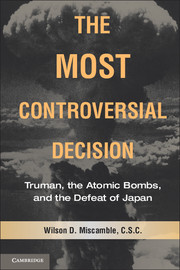Book contents
- Frontmatter
- Contents
- Acknowledgments
- Map 1 The Atomic Bombing of Japan
- Introduction: The Most Controversial Decision
- 1 Franklin Roosevelt, the Manhattan Project, and the Development of the Atomic Bomb
- 2 Harry Truman, Henry Stimson, and Atomic Briefings
- 3 James F. Byrnes, the Atomic Bomb, and the Pacific War
- 4 The Potsdam Conference, the Trinity Test, and Atomic Diplomacy
- 5 Hiroshima, the Japanese, and the Soviets
- 6 The Japanese Surrender
- 7 Necessary, But Was It Right?
- 8 Byrnes, the Soviets, and the American Atomic Monopoly
- 9 The Atomic Bomb and the Origins of the Cold War
- Suggested Readings
- Index
6 - The Japanese Surrender
Published online by Cambridge University Press: 05 June 2012
- Frontmatter
- Contents
- Acknowledgments
- Map 1 The Atomic Bombing of Japan
- Introduction: The Most Controversial Decision
- 1 Franklin Roosevelt, the Manhattan Project, and the Development of the Atomic Bomb
- 2 Harry Truman, Henry Stimson, and Atomic Briefings
- 3 James F. Byrnes, the Atomic Bomb, and the Pacific War
- 4 The Potsdam Conference, the Trinity Test, and Atomic Diplomacy
- 5 Hiroshima, the Japanese, and the Soviets
- 6 The Japanese Surrender
- 7 Necessary, But Was It Right?
- 8 Byrnes, the Soviets, and the American Atomic Monopoly
- 9 The Atomic Bomb and the Origins of the Cold War
- Suggested Readings
- Index
Summary
The first of the two nuclear weapons used in war caused a blinding explosion over the center of Hiroshima. It produced enormous damage and killed approximately eighty thousand people while wounding a similar number. Many of the maimed died soon thereafter from the effects of their exposure to the radioactivity let loose by the explosion. The bomb caused carnage and devastation for five square miles. One observer who entered Hiroshima on August 7 described it simply as “a city completely destroyed.” He recalled it as an “indescribable spectacle,” indeed as “a macabre vision which staggered the imagination.” Scenes of horror and suffering overwhelmed those who sought to rescue the victims of the unprecedented assault.
Hiroshima contained military targets – a military headquarters, an assembly area for troops, a communications center, and a port that served as the main embarkation center for China – yet its civilian residents suffered greatly from the destructive power of the atomic blast. The Japanese government emphasized the civilian nature of the target in the protest it transmitted to the United States through the good offices of the Swiss government on August 9. The statement contested Truman's claim that Hiroshima counted as a military target noting that the city lacked “military fortifications or installations.” It zeroed in on the indiscriminate nature of the bomb, pointing out that “the zone of damage spread over a wide area and all persons within this area, without discrimination as to belligerents and non-belligerents and irrespective of sex or age, were killed or wounded by the blast and radiated heat.”
- Type
- Chapter
- Information
- The Most Controversial DecisionTruman, the Atomic Bombs, and the Defeat of Japan, pp. 94 - 111Publisher: Cambridge University PressPrint publication year: 2011



